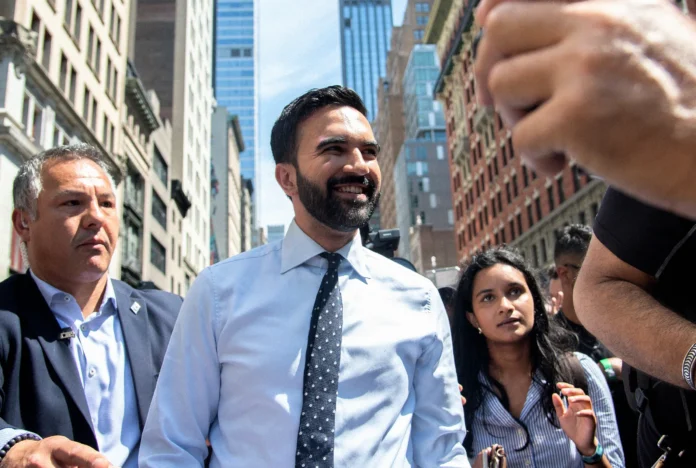The 2025 New York City mayoral race has become a referendum on trust and direction. Incumbent Eric Adams is battling the political gravity of a federal corruption indictment and historically poor job-approval numbers, while Zohran Mamdani, a 33-year-old democratic socialist assemblymember, has turned a primary upset into a citywide movement grounded in affordability, transit, and clean government. Early general-election snapshots show Mamdani with a clear lead, as national figures—and even the White House—test the boundaries of influence over Gotham’s politics. Department of JusticeQuinnipiac University PollAARP States
Why Adams’ Legal Troubles Reshaped the Race
Adams’ indictment on bribery and campaign-finance charges last year jolted the city’s political establishment and accelerated defections among once-reliable Democratic allies. The case, brought by federal prosecutors in the Southern District of New York, alleged a pattern of illicit benefits and foreign-linked fundraising—a narrative that has proved politically devastating. In March 2025, a Quinnipiac survey clocked his approval at 20%, the lowest of his tenure, underscoring the difficulty of rebuilding trust while running for reelection. Department of JusticeQuinnipiac University Poll
Compounding the challenge, Adams chose to bypass the Democratic primary and seek reelection as an independent, leaving space for a progressive standard-bearer to consolidate the Democratic vote. That opening helped Mamdani unify an anti-corruption, pro-affordability coalition—and kept the race focused on governing performance rather than personality. Wikipedia
Mamdani’s Path: From Queens Organizer to Frontrunner
Mamdani’s campaign has been unusually disciplined for a first-time citywide contender. His team capped public financing limits early, built a field program that saturates subway hubs and outer-borough retail corridors, and reframed “socialism” around tangible wins: taxi-driver debt relief, more frequent subway service, and a successful fare-free bus pilot—accomplishments he foregrounds from his Assembly record. Public polling in late August showed him leading the multi-candidate field, including in most “drop-out” scenarios, with affordability, housing, and safety as the decisive issues. zohranfornyc.comAARP States
A National Sideshow: Trump, Cuomo, and the “Clear the Field” Gambit
The contest’s oddest subplot is national. Reporting indicates President Donald Trump has privately urged two rivals to step aside to engineer a one-on-one showdown with Andrew Cuomo, whom Trumpworld views as the strongest anti-Mamdani option. The maneuver—publicly denied in parts, whispered in others—has become a campaign talking point as Mamdani’s team casts it as an outside attempt to override New Yorkers’ preferences. Coverage from mainstream and center-left outlets alike has framed the intervention as unusual and risky. The Washington PostNew York MagazineFox News
What Voters Are Saying Across the Boroughs
While the city is not monolithic, several patterns recur in public polling and on-the-record conversations captured by local outlets:
- Brooklyn & Queens: Cost-of-living pressure (rents, groceries, transit) dominates. Mamdani’s emphasis on fare affordability and tenant protections aligns with these anxieties; Adams’ message on public safety resonates with some older homeowners but is blunted by the indictment drag. AARP States
- The Bronx: Appetite for visible service improvements—cleaner streets, reliable buses, safer commercial strips—favors detailed policy deliverables over slogans; both camps court union households intensely. AARP States
- Manhattan: Professionals split between reform messaging and technocratic stability; swing segments track perceptions of competence and ethics, where Adams’ negatives remain high. Quinnipiac University Poll
- Staten Island: GOP-leaning areas respond to crime and quality-of-life frames; Mamdani’s ceiling here is lower, but cross-pressured independents cite corruption fatigue as a reason to consider alternatives. Quinnipiac University Poll
The Establishment vs. The Movement
The general election is shaping up as a three-lane contest—Mamdani (Democrat), Adams (independent incumbent), and a cluster of rivals including Cuomo and Curtis Sliwa—with overlapping vote pools and evolving “drop-out” calculations. Analysts note that the broader the field, the more a motivated progressive coalition can prevail with a plurality—especially if older undecided voters remain fragmented. Candidate trackers and explainer pieces from New York political outlets confirm the fluid roster and unusual realignment. City & State New YorkWikipedia
Policy Stakes: What Would Actually Change?
Affordability & Housing
Mamdani’s platform centers on rent relief, social housing pilots, expanded right-to-counsel, and accelerating conversions of vacant commercial space to residential—paired with stronger enforcement against price-gouging and wage theft. Adams counters with pro-development streamlining and a policing-first approach to quality-of-life complaints. The question is less about whether to build and more about who benefits and how fast. zohranfornyc.com
Transit & Mobility
Expect continued fights over MTA funding formulas and city-state cost shares. Mamdani leans into frequent service guarantees and targeted fare relief; Adams emphasizes capital delivery and police presence in the system. Voters consistently rank transit reliability among top determinants of daily quality of life. zohranfornyc.comAARP States
Ethics & Procurement
After a year of corruption headlines, clean-government commitments have salience. A Mamdani administration would face pressure to tighten vendor vetting, curb pay-to-play pathways, and publish granular contracting data by default; Adams argues that his team can deliver continuity while “fixing what went wrong.” The polling trend suggests trust remains the swing variable. Department of JusticeQuinnipiac University Poll
Electability Math: What the Numbers Suggest
- Approval drag: A 20% job approval for an incumbent is historically disqualifying unless opponents split in unusual ways. Even then, the ceiling problem is severe. Quinnipiac University Poll
- Issue alignment: Citywide concerns (affordability, housing, safety) map closely to Mamdani’s core messaging, per late-summer polling toplines. AARP States
- Field size: Should prominent rivals consolidate, the race tightens; if not, a progressive plurality path remains plausible. Tracker pieces and national coverage highlight this dynamic week to week. The Washington PostCity & State New York
What to Watch Next
- Ballot access & withdrawals: If any high-profile candidate exits, watch immediate shifts among older undecided voters and outer-borough moderates. The Washington Post
- Debate stage rules: A head-to-head (or trio) debate would clarify contrasts on housing and ethics and test Mamdani’s citywide appeal. City & State New York
- Cash on hand vs. spending cap: Public-match financing levels and independent expenditures could determine message saturation in the season’s final month. AARP States
Bottom Line
With the incumbent hobbled by legal peril and a trust deficit, New York’s race is tilting toward a stark choice: continuity amid controversy or a progressive reset centered on affordability and clean government. For now, the city’s mood—edgy about costs, impatient with scandal—gives Zohran Mamdani the initiative. Whether that edge hardens into a governing mandate will depend on late consolidations, debate moments, and one overarching question voters will answer in November: Who can be trusted to run the world’s most complicated city? Quinnipiac University PollAARP States




